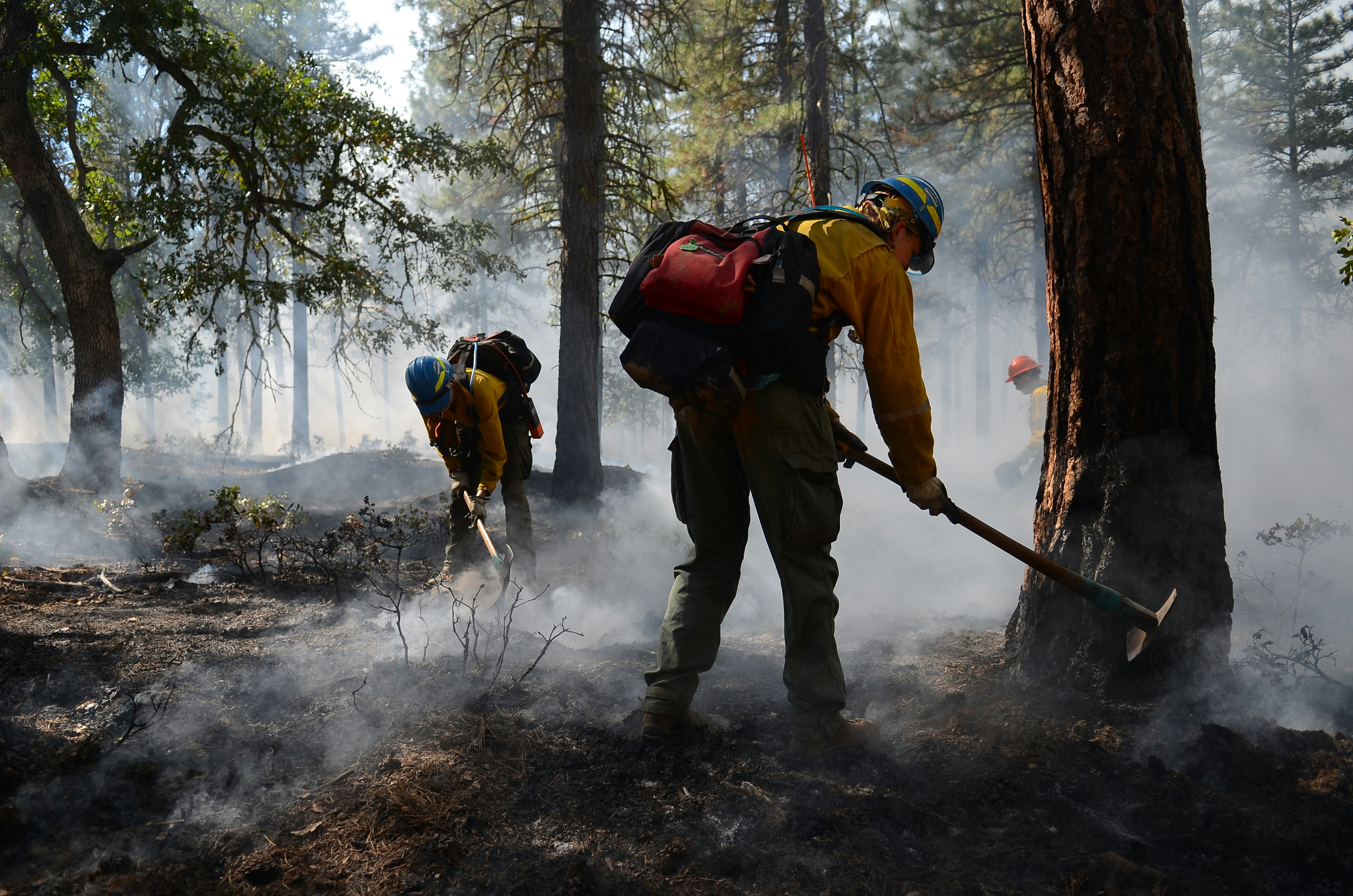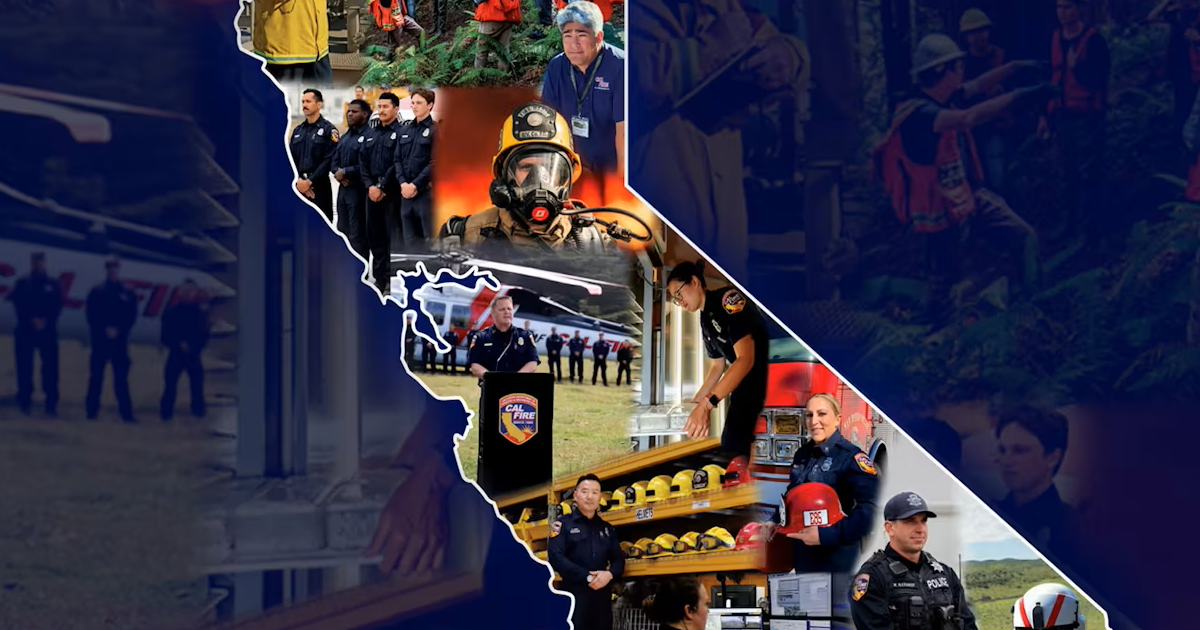
Firefighting and Prevention - Wildland Fire
Within fire and aviation jobs you will serve in a wide variety of roles, including understanding and monitoring fire conditions and behavior; pre-attack planning; preventing and suppressing damaging fires; controlling smoke; loading helicopters; and managing movement of people, equipment, and resources to support firefighting. Eventually you may expand to determining risk and develop or deploy programs designed to help combat wildfires with the best objectives. Includes specialty sub-groups of: Aviation, Fire Engine Operation, Fire Management Officer, Fire Management Planning, Fuels Management, Helitack, Hotshot Crews, Prevention, Smokejumper, Handcrews, and Paramedic.
Industry Insights
A high-level pulse check on talent demand, projected growth, compensation, and how work typically happens across this pathway.
Estimated employment nationwide in 2024
Projected change in employment through 2034
Mid-career annual salary (nationwide median)
How the work is typically performed
Shift‑based
Career Pathways & Progression
Position Responsibilities
Seasonal or apprentice firefighters gain experience on hand or engine crews under supervision. Wildland Firefighter (Forestry Aid/Technician) and Firefighter Type 2 positions construct fireline, use tools like Pulaski, shovel, chainsaw and bladder bag, assist with hoselays and mopping up. Entry workers must pass the arduous pack test and complete required basic training.
Job Types & Titles
- Wildland Firefighter (Forestry Aid/Technician)
- Firefighter Type 2 (FFT2)
- Seasonal Wildland Firefighter
- Wildland Fire Apprentice
Qualifications Snapshot
Education
High school diploma or equivalent; many agencies accept applicants at 18 years of age.
Certifications
NWCG Firefighter Type 2 qualification requires S‑130 Firefighter Training, S‑190 Introduction to Wildland Fire Behavior, L‑180 Human Factors, FEMA IS‑100/IS‑700 and the annual RT‑130 refresher.
Experience
No previous experience required; completion of the FFT2 position task book during the first season and strong physical conditioning are expected.
Position Responsibilities
Firefighters move into more responsible roles as Squad Bosses, engine crewmembers or helitack specialists. Firefighter Type 1 (FFT1) personnel lead small crews, coordinate hoselays and firing operations and supervise FFT2s. They perform initial attack and extended attack duties, requiring greater leadership and decision‑making.
Job Types & Titles
- Firefighter Type 1 (FFT1)
- Squad Boss
- Engine Crewmember
- Hotshot/Helitack Crewmember
Qualifications Snapshot
Education
Certificate or associate degree in wildland fire technology or natural resources is advantageous (e.g., Cosumnes River College Wildland Fire Technology program).
Certifications
FFT1 requires S‑131 Advanced Firefighter, RT‑130 and completion of the FFT1 task book. Engine crew members benefit from S‑230 Crew Boss, S‑231 Engine Boss and S‑219 Firing Operations training.
Experience
At least one season as an FFT2 with successful task book completion; proficiency with hand tools, pumps and basic leadership.
Position Responsibilities
Experienced firefighters advance to single‑resource leadership roles such as Crew Boss (CRWB), Engine Boss (ENGB), Helitack Squad Leader or Module Leader. They supervise crews, manage equipment and tactics, plan prescribed burns and serve on incident management teams.
Job Types & Titles
- Crew Boss (CRWB)
- Engine Boss (ENGB)
- Firing Boss (FIRB)
- Helitack Squad Leader
- Wildland Fire Module Leader
Qualifications Snapshot
Education
Associate or bachelor’s degree in fire science, forestry, fire ecology or natural resources; programs like Cal Poly’s Forest and Fire Sciences degree prepare students for leadership roles.
Certifications
NWCG requires S‑230 Crew Boss, S‑290 Intermediate Wildland Fire Behavior, RT‑130 and satisfactory performance as FFT1. Additional development courses include S‑219 Firing Operations, S‑270 Basic Air Operations and L‑280 Followership to Leadership.
Experience
Three to five seasons in wildland fire with documented leadership assignments and completion of relevant position task books.
Position Responsibilities
Management roles oversee entire fire programs, budgets and staff. Fire Management Officers (FMO), Assistant FMOs and Fire Chiefs plan and coordinate fire suppression, fuels management, prevention and incident command across large jurisdictions. They engage in strategic planning, community outreach and interagency coordination.
Job Types & Titles
- Assistant Fire Management Officer (AFMO)
- Fire Management Officer (FMO)
- Fire and Fuels Program Manager
- Fire Chief
- Incident Commander/Operations Section Chief
Qualifications Snapshot
Education
Bachelor’s degree in fire science, forestry, natural resources or a related field (e.g., B.S. in Wildfire Science & the Wildland Urban Interface); many managers hold graduate degrees in natural resources management or public administration.
Certifications
Advanced NWCG incident management courses (S‑330 Task Force/Strike Team Leader, S‑339 Division/Group Supervisor, S‑390 Fire Behavior Calculations, L‑380 Fireline Leadership) and agency‑specific Fire Program Management qualifications.
Experience
Five to ten years of progressive wildland fire experience including crew supervision, prescribed fire planning and participation on incident management teams.
Who Hires Firefighting and Prevention - Wildland Fire Professionals?
Explore leading organizations in this field and discover career opportunities.
U.S. Forest Service
National Park Service - Fire & Aviation
Bureau of Land Management
Bureau of Indian Affairs - Division of Wildland Fire Management
U.S. Fish & Wildlife Service - Fire Management

CAL FIRE - California Department of Forestry and Fire Protection
Washington State Department of Natural Resources
Oregon Department of Forestry
The Nature Conservancy - Fire Management Program
Words from the Field
Hear from professionals who have built successful careers in firefighting and prevention - wildland fire.
Resources & Tools
Curated guides, videos, and communities to help you level up quickly.
Resource
Jobs in Firefighting and Prevention - Wildland Fire
Still Deciding?
Use our tools and resources to explore firefighting and prevention - wildland fire and related fields.
Explore Your Options
Not sure where to start? Let us help you match your skills to your next career move, or get alerts for jobs that fit your goals.